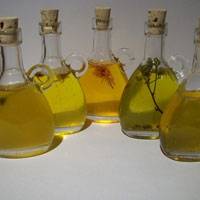Vegetable oil degumming is the removal of phospholipids from the crude product. Those are fat-like substances, highly valuable biologically. Actual content of phospholipids in vegetable oil varies from 0.2 to 4.5% and depends on the specific substance and the method of oil production.
Immediately after oil extraction, phospholipids are solved in the oil, but can lose that solubility in storage and precipitate, clouding the product.
Degumming is based on the ability of phospholipids to attach to water and form insoluble hydrated substances which can precipitate. This process requires 0.5 to 6% water.
The process is as follows. Continuous degumming starts by heating the oil to 45-50 ºС and then mixing it with water. The moist product is then supplied to a special device where hydrated phospholipids form. Oil is separated from sediment, then dried at 85-90 ºС. The process lasts until moisture content is 0.05%.
The content of phospholipids in degummed oil usually does not exceed 0.2-0.3%. Beside the reduction of phospholipid content, degumming lowers the oil’s acidity, improves its color, removes protein, hydrocarbons and solid particles. The substance separated from the oil is dried and phosphate concentrate is obtained, which can then be used for the production of margarine, bread baking, etc.
GlobeCore has developed AVS-100 vortex layer device for intensification of food production processes.
To prevent the oil from clouding when stored in cold temperature, the oil is winterized, removing wax and paraffin. This process is described in this article.
To reduce the amount of free fatty acids in the oil, those are neutralized by alkali or strong base salts. The result of this treatment is the formation of salts insoluble in oil: soaps. Sodium or potassium hydroxide, calcinated water, ammonia and other substances are used for neutralization. Concentration and temperature of the alkali solution is defined based on the acidity of the oil. To remove the remaining oil, the product is washed by hot water 3 or 4 times and dried.
In the degumming process, equipment choice is important. At this stage of food industry development, it is the equipment and machinery that defines the quality of the finished product and process efficiency, that is, profits.
GlobeCore has developed AVS-100 vortex layer device for intensification of food production processes. This unit is specifically designed for mixing of components. Existing equipment cannot ensure adequate component mixing and contact, leading to reagent overruns and degraded stability and quality of the oil.
In optimal conditions (i.e. the weight of ferromagnetic elements and processing duration) the degumming of vegetable oil in a vortex layer device reduces the content of:
- Р-based substances by 88.2-90.3%;
- Non-saponifiable substances by 26.8-34.6%;
- Ash by 94.7–96.2%.

